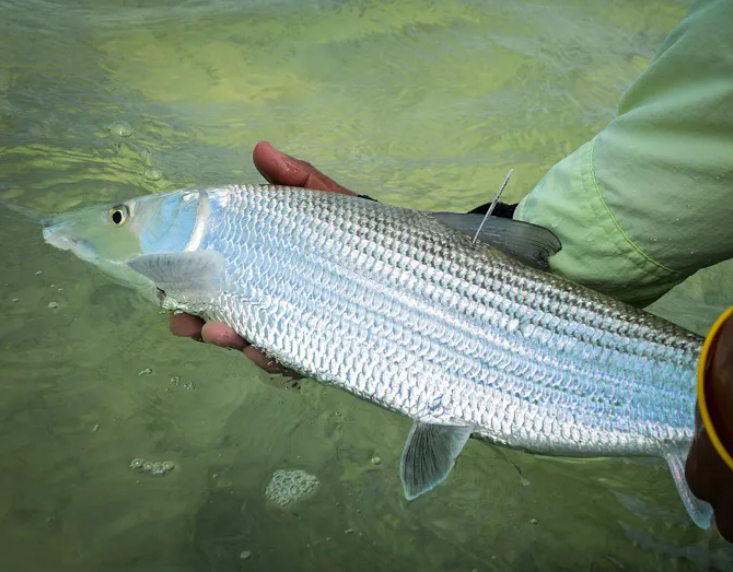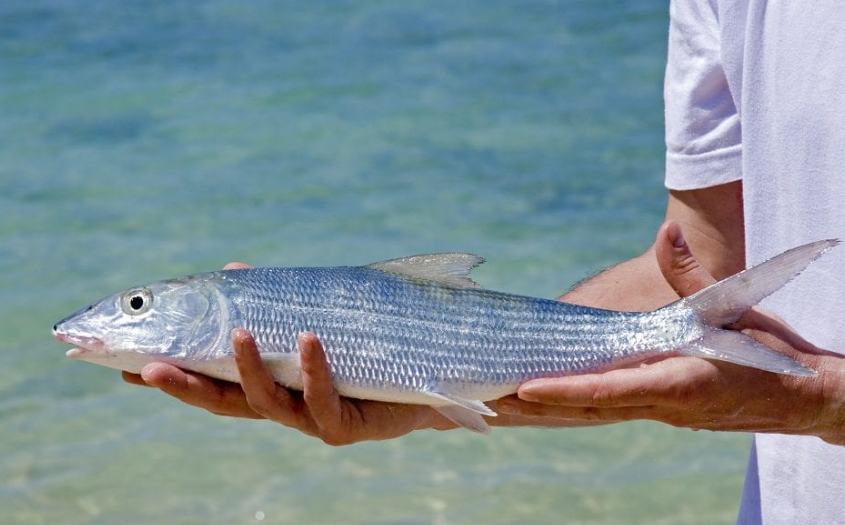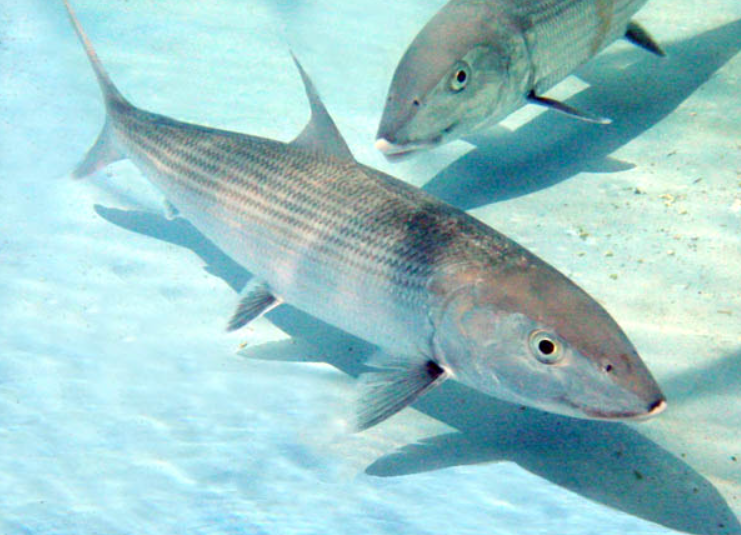Quick Top 10 Facts about Bonefish
| SCIENTIFIC NAME | Albula vulpes |
| CLASSIFICATION |
KINGDOM: Animalia PHYLUM: Chordata CLASS: Actinopterygii ORDER: Carangiformes FAMILY: Albulidae GENUS: Albula SPECIES: A. vulpes |
| SIZE | Length: Up to 1 meter, Weight: Up to 10 kg |
| HABITAT | Shallow coastal waters, particularly in tropical and subtropical regions |
| DIET | Small crustaceans, mollusks, and occasionally small fish |
| SPECIES | One primary species: Albula vulpes, also known as the common bonefish |
| COUNTRY | Found in coastal waters of the Atlantic Ocean, Gulf of Mexico, and Caribbean Sea |
| GESTATION PERIOD | Spawning occurs in open waters; eggs hatch in about 24 hours |
| LIFE SPAN | Typically 10-15 years, although some may live longer |
| CONSERVATION STATUS | Not currently endangered but affected by overfishing and habitat loss |
Amazing Facts About Bonefish
1. Bonefish are incredibly fast swimmers
Known for their speed, bonefish can reach speeds of up to 40 miles per hour when they are startled.
2. Bonefish are often referred to as the “ghosts of the flats”
Their sleek bodies and quick movements make them hard to spot in shallow coastal waters.
3. Bonefish have specialized bones
Their name comes from the fine, thin bones in their body, which can sometimes make them difficult to fillet.
4. Bonefish are a popular target for sport fishermen
They are highly sought after for catch-and-release fishing due to their challenging and exciting fight.
5. Bonefish have excellent vision
Their keen eyesight helps them detect predators and prey in the often murky waters of shallow bays and lagoons.
6. They are primarily solitary
Bonefish are usually found alone or in small groups, making them more difficult to track in the wild.
7. Bonefish play a crucial role in the ecosystem
As predators, they help maintain the balance of small fish and crustacean populations in coastal waters.
8. Bonefish spawn in open water
They do not form large breeding groups but rather spawn in the open ocean, allowing their eggs to drift with the current.
9. They can tolerate changes in salinity
Bonefish are adapted to live in both saltwater and brackish waters, which allows them to thrive in a variety of coastal environments.
10. Bonefish populations are threatened by overfishing
Despite being abundant in some areas, overfishing and habitat destruction are concerns that could impact their long-term survival.
Introducing the Facts about BoneFish
The scientific name for bonefish is Albula vulpes, and it belongs to the Albulidae family of fish. The primary tropical and subtropical seas where they may be found include the Atlantic Ocean, Caribbean Sea, and Gulf of Mexico. Due to their challenging habits and propensity for hiding, fishermen highly prize these fish.
Elongated bodies and appearance of BoneFish
The morphological characteristics of bonefish are unique. Their elongated and slender physique, along with their silvery hue, aids in their environmental integration. Their greatest length is three feet, and their maximum weight is nineteen pounds. One of their most distinctive features is their enormous, deeply forked tail, which allows them to swim at high speeds and make acute turns.
Preferred habitats of BoneFish
These fish are often found in shallow coastal areas, such as seagrass beds, mangroves, and flats. Owing to their distinct morphological characteristics and keen eyesight, they are well known for their effortless navigation of these shallow areas. Bonefish are very adaptable and can thrive in both brackish and saltwater environments due to their tolerance for a wide range of salinities.
Feeding habits of BoneFish
Mostly carnivorous, bonefish eat a variety of foods, including crabs, tiny fish, and crustaceans. With the aid of their powerful jaws and pointed fangs, they capture and consume their victim. Because of the manner in which they feed, bonefish are often found in places with an abundance of food sources, such as prawns and crab flats.
Impressive swimming speed and agility of bonefish
Fishermen find it challenging to capture these fish due to their exceptional speed and agility. They have a reputation for going on long, powerful runs when they are caught, sometimes ripping the line off the reel in a matter of seconds. Anglers often use specialised techniques like fly fishing and sight fishing to hunt bonefish. Because they are so elusive and the chase so thrilling, bonefish are prized by fishermen worldwide.
Essential role played by bonefish for ecosystem
Bonefish are essential to the ecosystem because they are both predators and prey. They help control the population of smaller fish and invertebrates and provide food for larger predators like sharks and barracudas. Because they live in coastal areas, they also contribute to the overall well-being and biodiversity of these ecosystems.

Most vulnerable due to habitat loss and overfishing of BoneFish
Despite being a highly sought-after species by fishermen, overfishing, habitat degradation, and pollution have led to significant reductions in bonefish populations in some regions. Conservation measures such as catch-and-release policies and the establishment of marine protected areas
Fascinating facts about Bonefish
Within the fish kingdom, bonefish are often considered to be among the most intriguing and difficult-to-find species. Bonefish, which are found in tropical and subtropical areas, are renowned for their slim bodies, remarkable speed, and difficult fishing conditions. Fishermen and environmental lovers alike are enthralled by the amazing animals known as bonefish. They are still a popular species for sport fishing because of their svelte build, remarkable speed, and secretive character. To preserve the survival of these wonderful fish for the enjoyment of future generations, it is imperative that we respect and conserve them.
Size, Appearance and physical Characteristics of Bonefish
Bonefish are readily identified by their distinctive look. Their body is long and lean, and their silvery colouring helps them blend in with the environment. Bonefish may reach lengths of 19–24 inches and weights of 3–6 pounds on average. Nonetheless, studies have shown that bonefish have grown to over 40 inches in length and over 15 pounds in weight!
Ability to tolerate both saltwater and freshwater environments by BoneFish
Shallow coastal waters, such as flats, lagoons, and streams surrounded by mangroves, are the main habitats for bonefish. These people choose muddy or sandy bottoms because they make it easier for them to find food. Because of their great adaptability and tolerance for a broad variety of salinities, these fish can live in brackish and saltwater habitats.
Ability to detect vibrations of food and scents in the water by BoneFish
Bonefish have a varied diet and are opportunistic eaters. Their main food source is tiny crustaceans, which include prawns, crabs, and small mollusks. They dig around the muddy or sandy bottoms, using their large snouts, to find food. As expert hunters, bonefish are renowned for their capacity to sense vibrations and other disturbances in the water.
impressive swimming speed and agility of BoneFish
The extraordinary speed and agility of bonefish are among their most remarkable features. They are among the fastest fish in the water since they can achieve speeds of up to 40 miles per hour. They provide a difficult target for fishermen because of their powerful bodies and tails that have a crescent form that enable them to turn quickly and precisely.
Catch and release conservation methods for Protection of Bonefish
Sport fishermen often catch bonefish because of its popularity. To maintain the sustainability of bonefish populations, catch-and-release methods are becoming more and more important. In addition to giving fishermen the excitement of landing a bonefish, catch and release conservation benefits future generations by protecting the species.
Unique adaptations that Bonefish have developed for spawning
The distinct spawning habits of bonefish contribute to their enigmatic appeal. High tides that inundate the flats during the full and new moon phases are usually when they spawn. Male bonefish make “bowls,” or little indentations in the sand, where females deposit their eggs. Within 24 hours of fertilisation, the eggs hatch, and the departing tide carries the larvae out to sea.

Conservation status of BoneFish, mentioning their vulnerability to habitat loss and overfishing
Bonefish populations are threatened by overfishing, pollution, and habitat loss, much like many other fish species. Conservation groups and fishing communities have put policies like harvest restrictions, marine protected zones, and educational initiatives into place to safeguard bonefish and their ecosystems. The long-term survival of bonefish and the environments they live in is the goal of these initiatives.
Bonefish’s economic importance and significance to fishing industry
In addition to their ecological value, bonefish support the regional economy. Bonefish tourism is a major industry for many coastal towns, drawing fishermen from all over the globe who come to experience the excitement of landing these elusive fish. The money made by bonefishing supports neighbourhood companies, generates employment, and encourages environmentally friendly fishing methods.
FAQ (Frequently Asked Questions) about Bonefish
Q: What is a Bonefish?
Ans: The Bonefish (Albula vulpes) is a species of fish that is highly sought after by sport fishermen for its speed and agility. Known for its silvery appearance and long, slender body, the Bonefish is typically found in shallow coastal waters, especially in tropical and subtropical regions.
Q: Where do Bonefish live?
Ans: Bonefish are commonly found in shallow coastal waters, especially in warm, tropical and subtropical regions. They inhabit sandy flats, mud flats, and estuaries, and are often found in areas near reefs and mangroves. Popular locations include the Caribbean, Gulf of Mexico, and parts of the Pacific Ocean.
Q: Why are Bonefish important to anglers?
Ans: Bonefish are considered one of the most exciting fish to catch due to their impressive speed and fighting ability. Known as the “ghost of the flats” because of their elusive nature, they provide a challenging and rewarding experience for sport fishermen. They are highly prized in catch-and-release fishing tournaments.
Q: What do Bonefish eat?
Ans: Bonefish are primarily bottom feeders and feed on small invertebrates like crustaceans, worms, and mollusks. They also eat smaller fish and other organic matter found in the sandy or muddy bottoms of their coastal habitats.
Q: How big do Bonefish grow?
Ans: Bonefish typically range from 10 to 30 inches in length, but some individuals can grow up to 40 inches long. They are known for their long, slender bodies and powerful tails, which allow them to reach impressive speeds when swimming.
Q: Are Bonefish endangered?
Ans: Bonefish are not currently listed as endangered, but their populations are impacted by overfishing, habitat destruction, and changes in water quality. Conservation efforts to protect their habitats and promote sustainable fishing practices are important to ensure the species’ survival.
Q: How do Bonefish behave?
Ans: Bonefish are known for their elusive behavior and speed. They are typically solitary or found in small groups, and they prefer shallow, clear waters where they can feed and evade predators. Their sensitivity to disturbances makes them difficult to catch, adding to their reputation as challenging prey for anglers.
Q: Can Bonefish be kept as pets?
Ans: Bonefish are not suitable as pets. They require a specific, large, natural habitat with the right water quality, temperature, and diet to survive. Keeping them in an aquarium would be difficult and stressful for the fish, and it’s best to admire them in their natural environment.
Q: What are the main threats to Bonefish populations?
Ans: The main threats to Bonefish include overfishing, especially in areas where they are targeted for sport fishing, destruction of their coastal habitats due to human activity, and pollution. Changes in the environment, such as warming ocean temperatures and coral reef decline, can also impact their populations.
Q: How fast can Bonefish swim?
Ans: Bonefish are extremely fast swimmers, capable of reaching speeds of up to 20 miles per hour (32 km/h) when they feel threatened. This speed, combined with their agility and ability to make quick turns, makes them difficult for predators and anglers to catch.
#Bonefish, #Fishing, #SportFishing, #TropicalFish, #CoastalWaters, #AnglerChallenge, #CatchAndRelease, #FishConservation, #MarineLife, #FishingInTheCaribbean, #BonefishFishing, #GhostOfTheFlats
Our sources and references about Bonefish
1: Wikipedia – Bonefish
2: NOAA – Bonefish
3: National Geographic – Bonefish
4: Florida Museum – Bonefish


